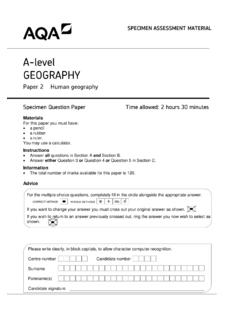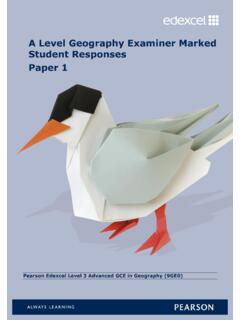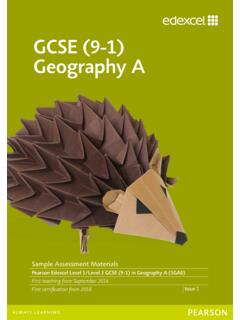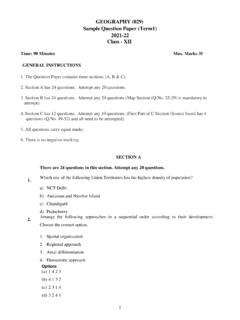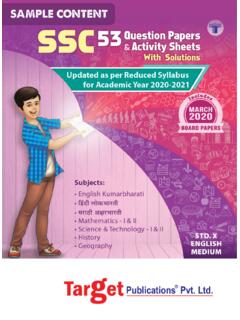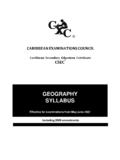Transcription of H481/02 Human interactions Sample Question Paper
1 OCR 2016 H481/02 Turn over QN 601/8576/4 R10054/10 Oxford Cambridge and RSA A Level geography H481/02 Human interactions Sample Question Paper Date Morning/Afternoon Time allowed: 1 hour 30 minutes You must have: the Resource Booklet the OCR 12-page Answer Booklet (OCR 12 sent with general stationary) You may use: a ruler (cm/mm) a piece of string a scientific or graphical calculator * 0 0 0 0 0 0 * INSTRUCTIONS Use black ink. You may use an HB pencil for graphs and diagrams. Section A: Answer all questions. Section B: Choose either option A or option B and answer all parts of the Question in the chosen option. Choose either option C or option D and answer all parts of the Question in the chosen option. Write your answer to each Question in the Answer Booklet.
2 Additional Paper may be used if required but you must clearly show your candidate number, centre number and Question number(s). Do not write in the bar codes. The separate Resource Booklet will be found inside this document. INFORMATION The total mark for this Paper is 66. The marks for each Question are shown in brackets [ ]. Quality of extended response will be assessed in questions marked with an (*). This document consists of 4 pages. SPECIMEN2 OCR 2016 H481/02 Section A Changing Spaces, Making Places Answer all parts of Question 1 1 (a) Study Fig. 1 which shows a photograph of part of a city in the UK in 2014. Explain how one piece of evidence from Fig. 1, shows this place has been rebranded to construct a new place image. [3] (b) Study Fig. 2, which shows information collected from a coastal town to form part of a place profile.
3 Using evidence from Fig. 2, explain why this coastal town has contrasting representations. [8] (c) Explain how globalisation can influence people s sense of place. [6] (d)* Placemaking is used by governments only to attract inward investment. How far do you agree with this statement? [16] SPECIMEN3 OCR 2016 H481/02 Turn over Section B Global Connections Answer two questions: either Question 2 or Question 3 and either Question 4 or Question 5. All questions are worth 17 marks. Either Option A Trade in the contemporary world 2 (a) Study Fig. 3, which shows the share of world merchandise exports by country, 2013. (i) Suggest two ways the share of world merchandise exports by country, shown in Fig. 3, can influence flows of people. [2] (ii) Explain one factor that might account for the spatial variations in Fig.
4 3. [3] (iii) For the data presentation technique shown in Fig. 3, suggest how effective the technique is for showing the share of world merchandise exports by country. [4] (b) With reference to a case study, explain how limited access to global markets is an obstacle to growth and development for low-income developing countries (LIDCs). [8] Or Option B Global Migration 3 (a) Study Fig. 4, which shows the number of immigrants living in the USA by country of birth, 2013. (i) Suggest two ways the number of immigrants living in the USA by country of birth, shown in Fig. 4, can influence flows of money. [2] (ii) Explain one factor that might account for the spatial variations in Fig. 4. [3] (iii) For the data presentation technique shown in Fig. 4, suggest how effective the technique is for showing the number of immigrants living in the USA by country of birth.
5 [4] (b) With reference to a case study, explain how emigration from a low-income developing country (LIDC) can provide opportunities for that LIDC. [8] SPECIMEN4 OCR 2016 H481/02 Either Option C Human Rights 4* Social factors are the most important influences responsible for gender inequalities. Discuss. [16] Or Option D Power and borders 5* For local communities in areas of conflict, intervention can create more problems than it solves. Discuss. [16] END OF Question Paper Copyright Information: OCR is committed to seeking permission to reproduce all third-party content that it uses in the assessment materials. OCR has attempted to identify and contact all copyright holders whose work is used in this Paper . To avoid the issue of disclosure of answer-related information to candidates, all copyright acknowledgements are reproduced in the OCR Copyright Acknowledgements booklet.
6 This is produced for each series of examinations and is freely available to download from our public website ( ) after the live examination series. If OCR has unwittingly failed to correctly acknowledge or clear any third-party content in this assessment material, OCR will be happy to correct its mistake at the earliest possible opportunity. For queries or further information please contact the Copyright Team, First Floor, 9 Hills Road, Cambridge CB2 1GE. OCR is part of the Cambridge Assessment Group; Cambridge Assessment is the brand name of University of Cambridge Local Examinations Syndicate (UCLES), which is itself a department of the University of R10054/08 ..day June 20XX Morning/Afternoon A Level geography H481/02 Human interactions Sample MARK SCHEME Duration: 1 hour 30 minutes MAXIMUM MARK 66 This document consists of 36 pages SPECIMENH481/02 Mark Scheme June 20xx 2 MARKING INSTRUCTIONS PREPARATION FOR MARKING SCORIS 1.
7 Make sure that you have accessed and completed the relevant training packages for on-screen marking: scoris assessor Online Training; OCR Essential Guide to Marking. 2. Make sure that you have read and understood the mark scheme and the Question Paper for this unit. These are posted on the RM Cambridge Assessment Support Portal 3. Log-in to scoris and mark the required number of practice responses ( scripts ) and the required number of standardisation responses. YOU MUST MARK 10 PRACTICE AND 10 STANDARDISATION RESPONSES BEFORE YOU CAN BE APPROVED TO MARK LIVE SCRIPTS. TRADITIONAL Before the Standardisation meeting you must mark at least 10 scripts from several centres. For this preliminary marking you should use pencil and follow the mark scheme. Bring these marked scripts to the meeting.
8 MARKING 1. Mark strictly to the mark scheme. 2. Marks awarded must relate directly to the marking criteria. 3. The schedule of dates is very important. It is essential that you meet the scoris 50% and 100% (traditional 50% Batch 1 and 100% Batch 2) deadlines. If you experience problems, you must contact your Team Leader (Supervisor) without delay. 4. If you are in any doubt about applying the mark scheme, consult your Team Leader by telephone, email or via the scoris messaging system. SPECIMENH481/02 Mark Scheme June 20xx 3 5. Work crossed out: a. where a candidate crosses out an answer and provides an alternative response, the crossed out response is not marked and gains no marks b. if a candidate crosses out an answer to a whole Question and makes no second attempt, and if the inclusion of the answer does not cause a rubric infringement, the assessor should attempt to mark the crossed out answer and award marks appropriately.
9 6. Always check the pages (and additional objects if present) at the end of the response in case any answers have been continued there. If the candidate has continued an answer there then add a tick to confirm that the work has been seen. 7. There is a NR (No Response) option. Award NR (No Response) - if there is nothing written at all in the answer space - OR if there is a comment which does not in any way relate to the Question ( can t do , don t know ) - OR if there is a mark ( a dash, a Question mark) which isn t an attempt at the Question . Note: Award 0 marks for an attempt that earns no credit (including copying out the Question ). 8. The scoris comments box is used by your Team Leader to explain the marking of the practice responses. Please refer to these comments when checking your practice responses.
10 Do not use the comments box for any other reason. If you have any questions or comments for your Team Leader, use telephone, email or the scoris messaging system. 9. Assistant Examiners will send a brief report on the performance of candidates to their Team Leader (Supervisor) via email by the end of the marking period. The report should contain notes on particular strengths displayed as well as common errors or weaknesses. Constructive criticism of the Question Paper /mark scheme is also appreciated. SPECIMENH481/02 Mark Scheme June 20xx 4 10. Annotations Annotation Meaning SPECIMENH481/02 Mark Scheme June 20xx 5 11. Subject-specific Marking Instructions INTRODUCTION Your first task as an Examiner is to become thoroughly familiar with the material on which the examination depends.











